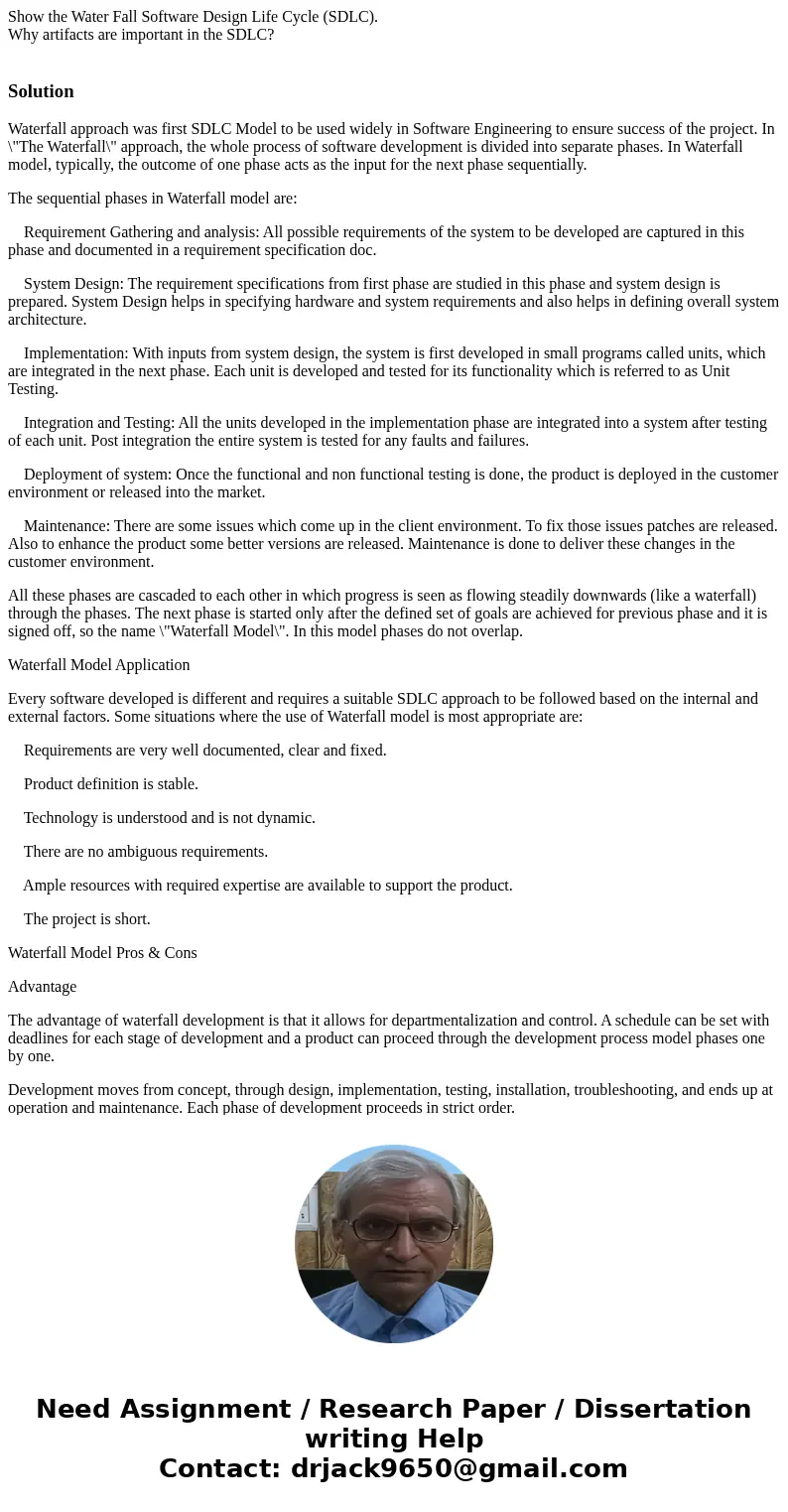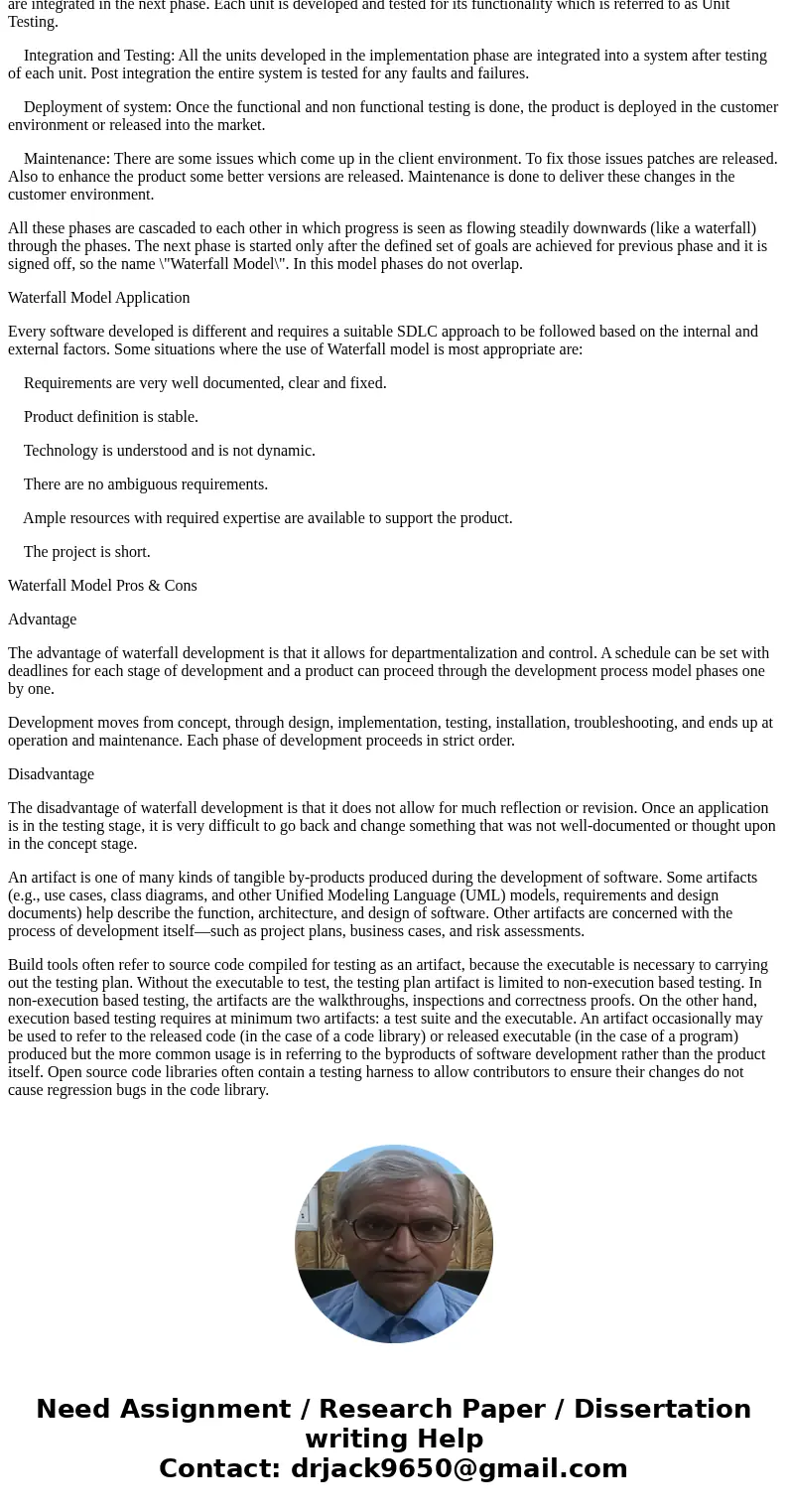Show the Water Fall Software Design Life Cycle SDLC Why arti
Show the Water Fall Software Design Life Cycle (SDLC).
Why artifacts are important in the SDLC?
Solution
Waterfall approach was first SDLC Model to be used widely in Software Engineering to ensure success of the project. In \"The Waterfall\" approach, the whole process of software development is divided into separate phases. In Waterfall model, typically, the outcome of one phase acts as the input for the next phase sequentially.
The sequential phases in Waterfall model are:
Requirement Gathering and analysis: All possible requirements of the system to be developed are captured in this phase and documented in a requirement specification doc.
System Design: The requirement specifications from first phase are studied in this phase and system design is prepared. System Design helps in specifying hardware and system requirements and also helps in defining overall system architecture.
Implementation: With inputs from system design, the system is first developed in small programs called units, which are integrated in the next phase. Each unit is developed and tested for its functionality which is referred to as Unit Testing.
Integration and Testing: All the units developed in the implementation phase are integrated into a system after testing of each unit. Post integration the entire system is tested for any faults and failures.
Deployment of system: Once the functional and non functional testing is done, the product is deployed in the customer environment or released into the market.
Maintenance: There are some issues which come up in the client environment. To fix those issues patches are released. Also to enhance the product some better versions are released. Maintenance is done to deliver these changes in the customer environment.
All these phases are cascaded to each other in which progress is seen as flowing steadily downwards (like a waterfall) through the phases. The next phase is started only after the defined set of goals are achieved for previous phase and it is signed off, so the name \"Waterfall Model\". In this model phases do not overlap.
Waterfall Model Application
Every software developed is different and requires a suitable SDLC approach to be followed based on the internal and external factors. Some situations where the use of Waterfall model is most appropriate are:
Requirements are very well documented, clear and fixed.
Product definition is stable.
Technology is understood and is not dynamic.
There are no ambiguous requirements.
Ample resources with required expertise are available to support the product.
The project is short.
Waterfall Model Pros & Cons
Advantage
The advantage of waterfall development is that it allows for departmentalization and control. A schedule can be set with deadlines for each stage of development and a product can proceed through the development process model phases one by one.
Development moves from concept, through design, implementation, testing, installation, troubleshooting, and ends up at operation and maintenance. Each phase of development proceeds in strict order.
Disadvantage
The disadvantage of waterfall development is that it does not allow for much reflection or revision. Once an application is in the testing stage, it is very difficult to go back and change something that was not well-documented or thought upon in the concept stage.
An artifact is one of many kinds of tangible by-products produced during the development of software. Some artifacts (e.g., use cases, class diagrams, and other Unified Modeling Language (UML) models, requirements and design documents) help describe the function, architecture, and design of software. Other artifacts are concerned with the process of development itself—such as project plans, business cases, and risk assessments.
Build tools often refer to source code compiled for testing as an artifact, because the executable is necessary to carrying out the testing plan. Without the executable to test, the testing plan artifact is limited to non-execution based testing. In non-execution based testing, the artifacts are the walkthroughs, inspections and correctness proofs. On the other hand, execution based testing requires at minimum two artifacts: a test suite and the executable. An artifact occasionally may be used to refer to the released code (in the case of a code library) or released executable (in the case of a program) produced but the more common usage is in referring to the byproducts of software development rather than the product itself. Open source code libraries often contain a testing harness to allow contributors to ensure their changes do not cause regression bugs in the code library.


 Homework Sourse
Homework Sourse